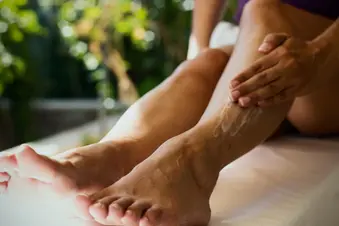
Psoriasis can show up on almost any area on your body, including your legs. In addition being itchy and possibly sore, these patches can make you feel less confident in your skin. But that doesn't mean you have to hide your skin in long pants. Exposing your psoriasis to natural sunlight for a moderate amount of time may help ease skin inflammation. And that can soothe flare-ups. Be sure not to spend more than 15 minutes without sunscreen or clothing over your skin; otherwise, you run the risk of burning and increasing your risk of skin cancer.
You can minimize and even conceal psoriasis patches on your legs.
Adjust your routine. A long, hot shower can make psoriasis worse. Try to keep your bath temperature warm, not hot. And don't stay in there too long. Ask your dermatologist about coal tar washes that you can use on your legs. They may also recommend using an exfoliating salicylic acid cleanser a few times a week to remove extra flakes.
Moisturize. After showering, moisturize your legs right away. Use a product your dermatologist recommends: something fragrance-free, hypoallergenic, and non-clogging. You may need to try several moisturizing creams or ointments to find one that doesn't sting or irritate your skin.
Know when to apply medicated creams. If your doctor has prescribed a corticosteroid product, you may want to apply it at night so it has time to absorb. Corticosteroid creams and ointments can stop the overproduction of skin cells that make psoriasis plaques, but makeup may not stick to skin that has a heavy cream or ointment on it.
Consider using a primer. Moisturizer absorbs into your skin, but makeup primers sit on top of it to create a smooth surface. That helps makeup stick better -- especially if your skin's surface isn't even because of your psoriasis plaques.
Apply cover-up. You can cover pink or red patches with a lightweight liquid foundation. Darker or more severe patches may need a heavier product (like “pancake” foundation). If you use a liquid or semi-liquid product, you can “set” it with powder and a brush.
You can also try a powder-based mineral foundation, which can be easy to apply with a makeup brush. These are ideal for covering larger flares. Keep in mind that your legs may not be the same skin color as your face, so you may have to try different colors to see what works best at hiding your patches. Skip products that sparkle or highlight. They can draw attention to problem areas. And never put makeup on an open wound or skin that's bleeding.
Take care with joints. If you're covering a patch on a joint like your knee, for example, bend it while you're putting on makeup. That will keep the makeup from separating or cracking when you move.
Remove makeup carefully. Use your fingers or a gentle cotton cloth or cotton balls and a gentle makeup remover to take makeup off. Petroleum-based removers soften makeup for removal. Harsh scrubs or cloths can make flare-ups more irritated.
Talk with your doctor. Flare-ups happen. But if your skin is constantly red and irritated or you almost never feel good about the way you look, it's time to talk to your doctor about adjusting your treatment plan. In addition to topical skin creams, there are other prescription medications that can help calm your body's immune system and control psoriasis symptoms.
Show Sources
Photo Credit: simarik / Getty Images
SOURCES:
Doris Day, MD, clinical associate professor of dermatology, New York University Langone Medical Centers.
Gary Goldenberg, MD, assistant clinical director of dermatology, Mount Sinai’s Icahn School of Medicine, New York,
National Psoriasis Foundation: "The Great Cover Up: Psoriasis Makeup," "Makeup Tips For Skin With Psoriasis."